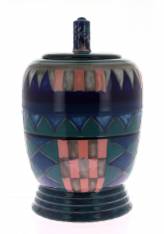THARAUD Camille
THARAUD Camille
Camille Tharaud (1878–1956) was a major figure in 20th-century French ceramics, renowned for bringing innovation to Limoges porcelain.
Born in Limoges on April 20, 1878, Tharaud developed an early passion for chemistry, which he studied at the Lycée Gay-Lussac and later at the École Supérieure in Bellac. During his studies, he met master glass artist Francis Chigot, whose influence played a decisive role in guiding him toward the world of porcelain.
His career took a pivotal turn after World War I. Seriously wounded in the head in 1914, he was evacuated to Paris and then sent to Limoges to recover. During this convalescence, he began experimenting with porcelain in the workshops of the long-abandoned Louis Tharaud factory—an establishment he had no family ties to. He acquired the premises in 1920 and modernized the facilities, replacing the outdated direct-flame kiln with a more advanced reversed-flame model.
A pioneer in the use of colored enamels, Camille Tharaud developed a distinctive technique: instead of painting on top of a hardened glaze, he managed to infuse color deep into the enamel itself. This gave his pieces a unique sense of depth, vibrant hues, and a soft, tactile quality. Drawing inspiration from the granite-rich stones of the Limousin region, he created bold and richly colored designs that became the hallmark of his work.
Between 1920 and 1924, he faced numerous challenges—limited color palettes, small and tentative decorative pieces—and came close to bankruptcy. Yet, with the help of financial backing, he persevered and ultimately succeeded in establishing himself as a master ceramist.
Camille Tharaud died on September 8, 1956, leaving behind a bold and original body of work that profoundly enriched the art of porcelain.

